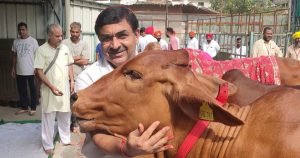Just before the semester end exams, UGC wants students to appear for a ‘Cow Science’ exam. Rajnish Jain, UGC Secretary wrote, “ I write this to request you, to give wide publicity to this initiative and encourage students to enrol/register themselves for this examination” in a letter to Vice-Chancellors of all universities.
Kamdhenu Gau Vigyan Prachar-Prasar Examination is an online national level examination. It is a voluntary exam being conducted by Rashtriya Kamdhenu Ayog. Vallabhbhai Kathiria, Chairperson of Kamdhenu Ayog earlier requested for wide publicity to make the examination a great success.
It has been called a ‘mammoth exercise’. It will be conducted on 25th February among various categories. Primary for students up to class 8th, secondary category for students of standard 9th to 12th. The next for university students and then for the general public. No registration fees is required to appear for the exam. Certificates will be provided to all participants and meritorious candidates will be prized.
The cow science exam is being organised with the aim to ‘infuse curiosity’ and to ‘sensitise and educate’ people on the importance of cows. If you are worried about your preparation, Rashtriya Kamdhenu Ayog has got you covered. You can test your cow knowledge via the mock test being organised on 21st February. A crash course might have been uploaded on Youtube for better chances of success in cow science.

Peeping into the Syllabus
The Syllabus covers a vast variety of topics to guarantee full knowledge to candidates about cow science. It talks in detail about ‘Panch Gavya’.
“Gobar is basionyms of two words; Gau (Desi Cow) and var (the best) ”
The cow has been called “Mother of the World”, as it was the first mammal to be domesticated by humans. A very skilled Fact-Check website found this claim to be false, as the dog was the first mammal to be domesticated. The syllabus covered the chemical components of cow urine. It provided details about it’s ‘germicidal power to kill varieties of germs.
“Cow urine is great elixir, proper diet, pleasing to heart, the giver of mental and physical strength, enhances longevity. It removes all blood disorders.”
Another insightful thing brought to notice was how cow dung is being used for protection against radiation in various nuclear centres across India and Russia. It also highlighted how cow-killings are the reason behind the increase in the number of earthquakes and how they are related to the stress history of rocks. How cows absorb solar energy with their hump.
It should be understood, the syllabus talks about only Native cows. A chart to differentiate it from the ‘Exotic cows’ of Jersey was also included. It stated that the colour of native cow’s milk has ‘light yellow as it has traces of Gold in it’. Another interesting difference marked between Indian Gaumata and ‘exotic cow’ was that, ‘Indian cows are hygienic, hardy and clever enough not to sit at dirty places. They are very active in Nature and shares warmth with all. Jersey/HF cows are known to be very lazy and highly prone to diseases. It has also been seen that they attract infection by not being hygienic enough. Whenever any unknown person comes near a desi cow, she will immediately stand whereas no emotions are displayed by exotic cows. She sits idle and is very inactive.’
Though some controversial elements from this have been removed from the English study material, some regional languages resource material still consists of these claims.
Priorities made clear
UGC, which is expected to raise the standards of education in India, supports the cow science exam. It’s support to amplify such exams with pseudo-scientific claims has been criticised by various academicians.
A nation that grapples with the issue of women’s safety, where horrific cases of rape occur almost daily. We all very well know where does our nation stand and what stand do citizens take. Sex Education is being delivered in the name and on papers only. Consent classes have been known to reduce cases of rape and gender issues. Still, there is no initiative or talks about it. The priorities are very clear. Thus, it won’t be wrong to say that cows in India are much more respected and valued than women of this country.
